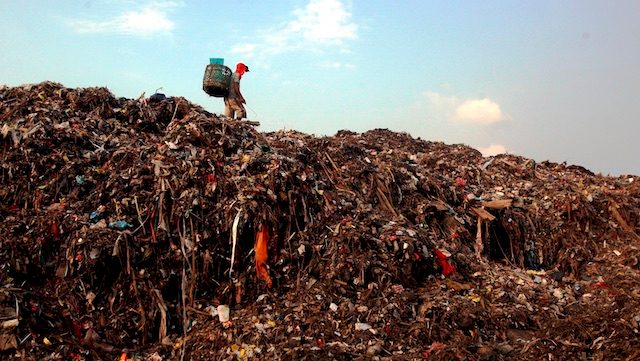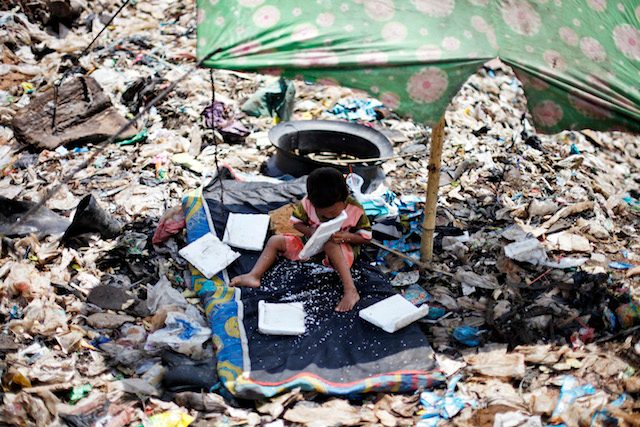SUMMARY
This is AI generated summarization, which may have errors. For context, always refer to the full article.

BEKASI, Indonesia – Sifting through a mountain of garbage with her bare hands, a thick cloth wrapped around her face to keep out the stench, Patimah recalled her early days scavenging at a dump on the outskirts of the Indonesian capital the size of 120 football fields.
“I vomited back then,” she told AFP while wading through knee-deep waste, swatting away flies as she hunted for plastic bottles amid food scraps and soiled clothing.
But now Patimah, who like many Indonesians goes by one name, said the smell no longer bothers her: “I am used to it.”
The same cannot be said for people living nearby, who are increasingly angry at the odors wafting from the tip, placing it at the center of a row that highlights the challenge for Jakarta and other developing cities in dealing with their waste.
Virtually all rubbish from Jakarta – a sprawling city of about 10 million with a booming middle class – is dumped an hour’s drive away at Bantar Gebang, in the city of Bekasi, where towering mountains of trash have risen skyward as the capital grows bigger and wealthier.
The absence of a citywide recycling scheme, and limited public awareness of “going green”, means the tip – already one of the world’s largest – is growing by an estimated 6,500 tons per day.
The job of sorting through the mountains of untreated waste falls to a 6,000-strong army of trash pickers, including many young children, who dodge heavy machinery and exposure to disease to eke out a living from the city’s filth.
Children at risk
As he wandered around searching for toys and paper as trucks tipped reeking waste nearby, 11-year-old Agung said his father was a trash picker while his mother sorted plastic at one of the many shanty towns that have grown up around the dumpsite.
“I come here after school,” he told AFP, as a friend hauled a bamboo basket carrying cans and plastic bottles on his back.
At the dump’s only school – it also has a dedicated mosque, salon and many shops selling food and cool drinks – principal Nasrudin fretted over his students, most of whom suffer skin infections, bronchial problems and intestinal worms from working on the tip.

“I am very, very worried about the safety of the children working around such heavy machinery,” he said, speaking from the school’s newly-built second floor, where the giant trash heaps are visible from classrooms.
“They are still small children, and they are not psychologically or physically ready for such work.”
In the 20 years Nasrudin has worked at the school, enrollment has soared as the first garbage mountain was joined by a second, then a third and fourth.
As the tip expanded, so did the shanty towns around it, with whole families relocating to scour for anything to sell on, including plastic, glass and aluminium.
Crouched among maggot-ridden earth outside his squalid shack, his hands black with filth, Paino said he tilled a rice field until drought forced him and his young family to find work elsewhere.
“Essentially, we had to make a living,” he said.
“Who knows, maybe we’ll make more than we did working in the rice fields,” he told AFP, adding he earned about 75,000 rupiah ($5) every day.
Going green
But elsewhere, Bantar Gebang represents a nuisance, with nearby communities – there are nearly 850,000 people living within 10 kilometers (6 miles) of the tip – furious at the odor and overfilled garbage trucks passing by 24 hours a day, spilling waste in their neighborhoods.
In November, the road to Bantar Gebang was blocked for days by angry residents, triggering a crisis as trucks backed up for miles and trash collection points quickly reached capacity.
The standoff dominated local headlines until Jakarta’s governor finally ordered police to escort the trucks to the dumpsite. But the issue is far from resolved and highlights a perennial problem facing many developing cities.
The world’s 50 biggest dumps identified last year by the non-profit Waste Atlas Partnership – behemoths that include Mbeubeuss in Senagal, Deonar in India and Estrutural in Brazil – are largely concentrated in the developing world, where rapid urbanization and rising incomes is putting even more strain on these sites.
The head of Jakarta’s public sanitation agency, Isnawa Adji, knows the city cannot rely on Bantar Gebang forever, and says authorities plan to build several world-class waste treatment facilities at significant cost to boost recycling and incinerate trash.
But in a city where canals and parks are littered with rubbish, and even the smallest purchase is often double wrapped in plastic, Adji knows he’s facing an uphill battle.
“The public aren’t educated about this,” he said, referring to the “reduce, reuse, recycle” signs outside his office.
“The most effective change begins in the home.” – Rappler.com
Add a comment
How does this make you feel?
There are no comments yet. Add your comment to start the conversation.